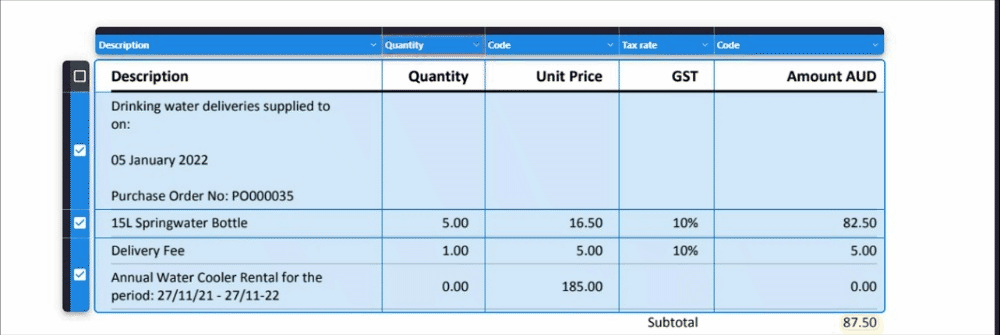Line Item Table Validation
Extracting all of the data located within line item tables within invoices and other documents can be a very time-consuming and error-prone process. With Affinda's validation interface, the extraction of data is reliable and fast using our intuitive table validation tool.
Opening table validation
Existing model prediction
In most invoices, Affinda's AI model will recognise the line item table within the document when initially processed. To validate these table predictions, simply click the rectangle that covers the line item table. The table validation tool will then open up and the data can be edited and validated.
New table
In some other cases, our AI model will fail to pick up all line items within an invoice or you may wish to re-draw the table. To do this, simply use the tool to create a rectangle around the entire table area and select "Line Item Table" from the dropdown. Our model will then make some predictions around the rows and columns within the table area which can then be edited and validated.

Editing rows and columns
To edit the rows and columns that the model has predicted, select "Edit Grid" in the bottom panel that appears when a line item table is selected.
Changing column and row dividers
Column dividers can be edited in three ways:
- Removing dividers - move the cursor to the top/left of the table where an existing divider appears and a red 'x' will appear
- Adding new dividers - move the cursor to the top/left of the table until a green line with a '+' appears
- Changing the location of dividers - select the blue divider and move to the desired location

Changing column type
At the top of the table editor, the type of column can be changed by clicking on the cell to show the dropdown of possible column types.

Note, that each column type has a data format associated with it which will also be updated. For example, if a value is changed from a code to a quantity value, the format will change in the table output from a text string to a number value.
Selecting output rows
Often, not every single row within a table will need to be exported. Users can choose to deselect rows that are not required in the output. This will include header rows, but also other text within a table that does not follow the structure of the line item components.

Updating table values
Once the table dividers, output rows, and column types are validated, click 'Apply' to save changes. The relevant rows will then be shown in the bottom panel where individual values within the table can then be edited. This can be useful to correct errors from scanned invoices, where our OCR engine has been unable to capture the data with 100% accuracy to due quality issues.
When any potential errors here are corrected, click "Confirm" and the table will be validated. While there are a few steps to validate each line item table, the accuracy in our model in predicting the correct columns and rows that are of relevance means that the validation time is only a matter of seconds in practice.
Updated about 1 year ago
